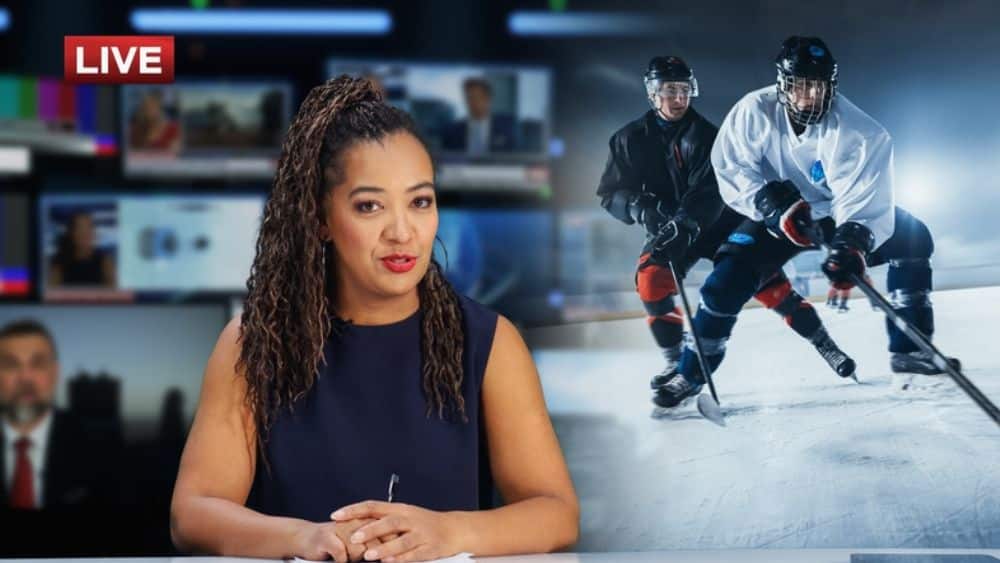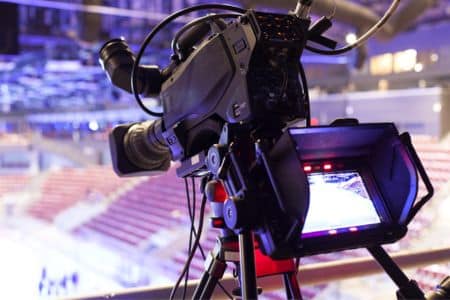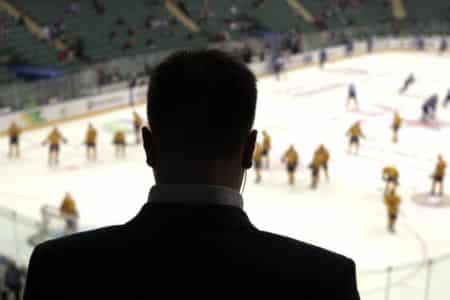
If the sound of skates carving ice and the crack of a one-timer sets your pulse racing, a career as a hockey broadcaster might be your calling. Whether you dream of doing play-by-play for an AHL club, serving as a color analyst for NHL telecasts, or hosting digital streams for junior teams, this guide breaks down the skills, experience, and sports broadcasting jobs path you’ll need, plus where to find real opportunities on Jobs In Sports.
What Does a Hockey Broadcaster Actually Do?
Hockey moves fast. Your job is to help fans see and feel the game—live.
- Play-by-Play Announcer (PBP): Calls the action as it happens. Crisp, accurate, high-tempo delivery that matches the pace of the sport.
- Color Analyst: Adds strategy, breakdowns, and storytelling, often a former player/coach providing context after each sequence.
- Rinkside/Studio Host: Drives interviews, pre/postgame hits, intermission analysis, and feature packages.
- Radio vs. TV vs. Streaming: Radio leans descriptive and imaginative; TV/streaming prioritizes pace, timing, and partnering with graphics/video.
Quick sample PBP moment to practice:
“McDavid crosses the blue line with speed—cuts inside, toe drag—dishes backdoor, SCORE! Hyman buries it! Edmonton strikes first with 14:27 left!”
The Core Skill Set for Hockey Broadcasters
- Rapid Game Read: Anticipate entries, forechecks, neutral-zone regroups, and odd-man rushes
- Vocabulary & Timing: Use concise, accurate terms (wraparound, high slot, cycle, bumper) and let big moments breathe.
- Story Crafting: Spotlight line chemistry, matchups, and player development arcs (AHL call-ups, juniors to pros).
- On-Air Discipline: Strong diction, steady cadence, and controlled energy in high-pressure moments.
- Technical Fluency: IFB etiquette, talkback with producers, and comfort with broadcast boards/mics.
- Prep Habits: Depth charts, pronunciation guides (ask PR), and 5–10 “if-this-then-that” storyline angles per game.
Education, Training & Certifications
- Majors/Programs: Communications, Journalism, Sports Media, Broadcasting.
- Workshops/Camps: Play-by-play bootcamps, on-camera workshops, voice coaching.
- Certifications: Audio engineering basics, video editing (Premiere, Final Cut), live-stream production tools.
- Clubs & Student Media: College radio/TV, student newspaper, and production teams to build clips quickly.
Build Reps Where Hockey Lives (Juniors, Colleges, Minors)
You don’t need to start in the NHL. Break in where access is high and reps are plentiful:
- Junior & College Hockey: USHL, NAHL, CHL, NCAA—many teams welcome emerging voices.
- Minor Leagues: ECHL, AHL, SPHL—great for road-warrior reps and versatility (PBP + media relations).
- Local & Regional Streams: Community rinks often need talent for tournaments and showcases.
- Freelance Packages: Film and voice-over scrimmages, drills, or alumni games (with permission) for your reel.
Create a Hockey Demo Reel That Wins Interviews
Your reel is your résumé. Aim for 60–90 seconds focused on hockey, then optionally include a 30-second studio/standup.
Must-haves:
- Clean open: name, role (“Play-by-Play | Hockey”), quick contact.
- 4–6 tight calls: even-strength rush, power play, penalty kill clear, goalie stand, and one high-emotion goal.
- One analyst segment: 10–15 seconds, breaking down a forecheck scheme or defensive coverage.
- Crisp audio: minimize music/graphics clutter; accurate lower-thirds.
Legal note: Always secure permission to use footage/audio. Many teams will approve clips if you credit them.
Network Like a Pro (Without Being Pushy)
- Team & League PR: Start with PR/media relations contacts for junior, college, and minor-league teams.
- Broadcaster Mentors: Ask for 10 minutes of feedback on a clip, then apply it and follow up later with your improved reel.
- Events & Clinics: League meetings, sportscaster workshops, and local media meetups.
- Social Presence: Share short, value-packed clips and tactful breakdowns of big games (avoid hot-take theatrics).
- Consistency > Virality: Regular, thoughtful content beats sporadic spikes.
Step-by-Step Playbook to Become a Hockey Broadcaster

1) Pick Your Track (PBP, Color, Host): Audit your strengths; split-second description vs. strategic analysis vs. hosting presence.
2) Build a Practice Pipeline: Call “silent” games off TV, record yourself, and compare to the live call. Iterate.
3) Join a Team—Any Team: Volunteer for a local junior/college program. Offer PBP, media notes, and social clips in one package.
4) Assemble a Hockey-First Reel: Lead your reel with two dynamic hockey sequences. Keep cuts tight and audio pristine.
5) Publish a One-Page Portfolio: Host your reel, short bio, contact, and 3 bullet “Why me” points. Add a downloadable résumé.
6) Apply to Sports Broadcasting Jobs: Target entry-level roles and sports broadcasting internships to stack real games quickly.
7) Pitch Yourself to Teams: Email PR with a concise note + reel link + two ways you add value (e.g., pregame notes, social recaps).
8) Prep Like a Pro: Create team cards: pronunciations, special-teams tendencies, goalie tracking, and situational storylines.
9) Gather Feedback & Re-Cut the Reel: After every 5–10 games, request notes, trim weaker calls, and elevate your best two new moments.
10) Climb the Ladder (ECHL → AHL → NHL): As your polish improves, target higher leagues and bigger platforms. Relationships and reliability win calls.
Game-Day Workflow You Can Steal
- T-24 hrs: Confirm lineups, recent transactions, and goalie plans; pull 3 opponent trends.
- T-3 hrs: Mark 10 storyline beats (rookie debut, point streaks, coaching adjustments).
- T-90 min: Meet PR, confirm pronunciations, scratch changes, and intermission interview targets.
- T-30 min: Final mic check and graphics timings; water + cough drops.
- Postgame: Tag your best 20–30 seconds, log teachable moments, follow up with PR.
Interview Tips for Hockey Broadcasting Roles
- Bring two reels (60–90 seconds and 2–3 minutes).
- Prepare a 15-second “what just happened” reset and a 30-second power-play breakdown on demand.
- Know the organization’s pipeline (ECHL ↔ AHL ↔ NHL affiliate) and how you will support PR/community content.
- Have a travel-ready mindset (back-to-backs, winter road swings, late arrivals).
Where to Find Hockey & Broadcasting Roles

- JobsInSports Hockey Jobs: Junior to pro roles across operations and media.
→ Hockey Jobs - Sports Media & Broadcasting: Play-by-play, color, production, and on-air hosting.
→ Sports Media Jobs - Related Reading: Starting out as a sports announcer and building skills.
→ Sports Announcers: How to Start Your Career
Set alerts on JobsInSports for “play-by-play,” “hockey broadcaster,” “sports commentator,” and “AHL/ECHL” so the right postings come to you.
Final Take
Hockey rewards broadcasters who prepare obsessively, communicate clearly, and keep pace with the game’s speed. Start where you can get the mic most often, build a reel that proves you can own big moments, and keep leveling up. When you’re ready, explore live openings on JobsInSports and take the next step.
Ready to get on the call sheet? Explore Sports Media Jobs and Hockey Jobs.
FAQs
Do I need to have played hockey? +
Playing helps vocabulary and intuition, but consistent practice + preparation = hireable.
How long should my reel be? +
Lead with a 60–90 second hockey-specific reel. Keep a longer 2–3 minute version on standby if requested.
Radio or TV to start? +
Whichever gives you more reps. Many broadcasters begin on radio/streaming, where opportunities are plentiful.
What about entry-level roles? +
Search entry-level sports broadcasting jobs and sports broadcasting internships—great ways to stack live games fast.
How do I move up leagues? +
Deliver reliable, accurate calls; build relationships; and keep upgrading your tape. Many climb from ECHL → AHL → NHL.





